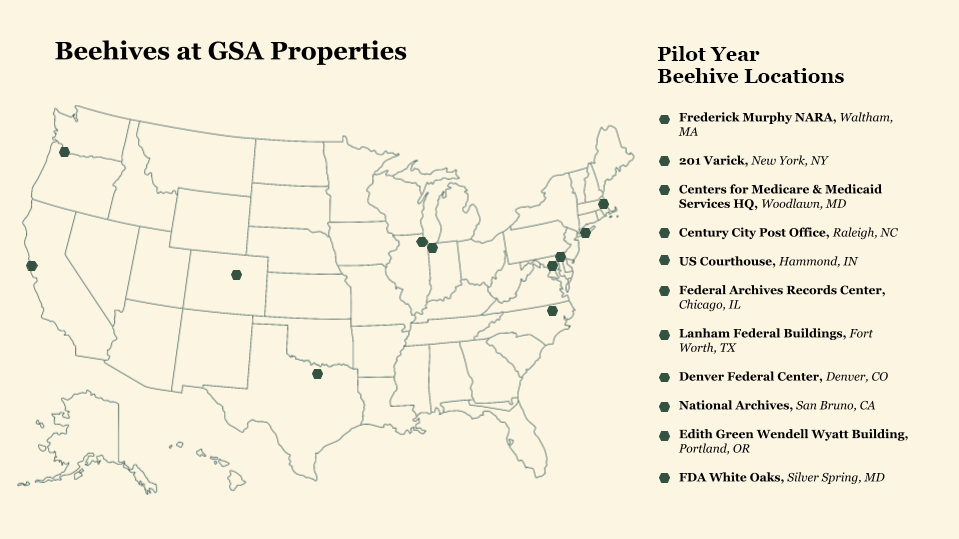In the spring of 2022, GSA placed beehives at 11 locations throughout the country. Known as GSA’s Pollinator Protection Initiative, this data-driven pilot supported the federal government’s commitment to do more to protect pollinators, including honey bees, which contribute more than $20 billion to the national economy each year. Honey bees have been in serious decline for more than three decades in the United States. Led by GSA’S Center for Urban Development, the program featured data-yielding beehives that were supported by GSA’s contractor, The Best Bees Company (Best Bees), and subject matter experts and facility managers throughout GSA’s Regions.

GSA’s Pollinator Protection Initiative is based on the Presidential Memorandum, Creating a Federal Strategy to Promote the Health of Honey Bees and Other Pollinators, which established an inter-agency Pollinator Health Task Force, on which GSA was a member, to develop a national strategy to promote the health of bees, butterflies, other pollinating insects, birds and bats. The Task Force issued the National Strategy to Promote the Health of Honey Bees and Other Pollinators [PDF] in May 2015. This initiative is one part of a broader GSA strategy to promote not just honey bees, but also to support the nearly 4,000 species of native bees and other native pollinating invertebrates, which are also in decline and in need of help.
During the pilot year, Best Bees and their network of local beekeepers created a series of Hive Tour Videos at GSA facilities to showcase the honeybee hives, explain the lifecycle and maturation of the bee colonies, and demonstrate how the hives were being maintained.
GSA currently has established detailed, pollinator-supporting planting standards to guide design development on all GSA project landscapes. These landscapes provide habitat, forage, and opportunity for pollinators to thrive through intentional design and management. The landscape standards are codified in Chapter 2 of the P100 and are the product of direction provided in Supporting the Health of Honey Bees and Other Pollinators, addendum to Guidance for Federal Agencies on Sustainable Practices for Designed Landscapes. GSA’s pollinator supporting landscapes with a diverse array of high-value blooming plant species are commonly planted at grade around our building facilities, in parking lots, in public use areas like plazas/ streetscapes, and in more naturalized areas. Often overlooked is the potential for existing green roofs, green roof retrofits, or freestanding roof planters to provide honey bee and pollinator supporting flora.
GSA’s Pollinator Protection Initiative ended in January 2023 with the completion of Best Bees’ “Honey DNA” research. Since the initial pilot year is over, individual regions now manage their own programs. Based on the experience of hosting the hives and the resulting Honey DNA data, GSA’s Center for Urban Development generated 6 key takeaways from the pilot year that may inform regional efforts:
- Proof of concept: Many regions had expressed interest in hosting honeybee hives, but ran into logistical hurdles. The pilot year proved successful in showing that hives can be hosted at GSA facilities and the possible frameworks that regions can use to do so.
- Public awareness: The experience of hosting hives on GSA property spread across the entire country has been extremely valuable. Interest and communication brings a much greater awareness to the plight of honeybees and by extension- native bees, other pollinators, and the continued need for creation of healthy habitat and pollinator forage landscapes.
- Beekeeping: The initiative provided a number of lessons on hive placement to include relation to wind breaks, water source considerations, drift prevention, and sourcing of bees that regions can use when considering future hive locations or modifying areas around hives to better support pollinators.
- Need for continued study: While GSA hosted a number of successful hives during the study, we did experience challenges and setbacks trying to host healthy hives. Although there’s no one single clear cause to point to in some cases for absconsion or general lack of production, experiencing these challenges underscores the point that more study in the health of honeybees and other pollinators is still needed.
- Biodiversity: The resulting data showed a wide diversity of plants supporting honeybees across the country, although it varied greatly from region to region. This will be a helpful barometer to identify specific places where intentionally increasing plant diversity could have a positive effect on the health of honeybee hives, and potentially other fauna.
- Support agriculture: Analysis of the HoneyDNA data suggests that honeybees hosted on GSA property were foraging offsite on agricultural crops, helping to support the local economy by pollinating local agricultural fields in the region.
The work relates to the following additional Federal policies or initiatives and can help GSA meet the sustainability and climate change goals of the Administration:
News stories
The Center will continue to facilitate the collection and sharing of lessons learned and best practices throughout GSA as efforts continue at the regional level. For information on this or for questions, please reach out to Amber Levofsky, Senior Program Advisor for GSA.

 U.S. General Services Administration
U.S. General Services Administration

